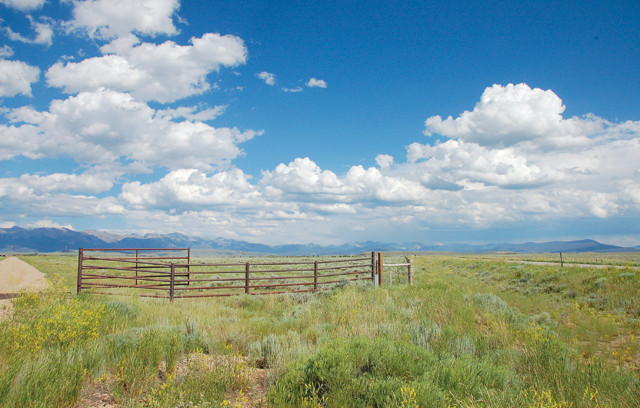
by Julia Rosen Tuesday, June 16, 2015

The High Plains form a vast plateau from Alberta, Canada, to Texas. Credit: ©Wusel007, CC BY-SA 3.0.
The mighty mountains of the American West may captivate artists and adventurers with their rugged allure, but it’s the humble High Plains that intrigue certain geologists. For decades, scientists have puzzled over the origins of this vast plateau, which stretches for more than 500 kilometers east of the Rockies.
Some have argued that the High Plains’ impressive elevation — up to 2 kilometers above sea level — simply results from the crust being thicker there, or from the lithosphere having lost some of the dense mantle at its base that would otherwise weigh it down. But there may be another explanation according to a new study in Geology: that the plains perhaps got a boost from below when chemical changes in the lower crust made it more buoyant.
Most scientists think that the plains’ uplift began during a period of mountain building called the Laramide Orogeny. That episode started about 70 million years ago when the oceanic Farallon Plate began subducting beneath North America at an abnormally shallow angle. The ensuing buckling and bending created the spine of mountains that now bisects North America, but this deformation did not affect the eastern portions of modern-day Montana, Wyoming and Colorado, which now form the heart of the High Plains.
The researchers behind the new study, led by Craig Jones of the University of Colorado at Boulder, suggest instead that the Laramide Orogeny may have lifted the plains through a different mechanism. They say that water released by the Farallon slab as it sank slowly into the mantle could have bubbled up into the lower crust and reacted with rocks there to form more buoyant minerals.
“Garnet is the magic mineral,” says Gene Humphreys, a geologist at the University of Oregon who was not involved in the work. It’s dense and fairly common in the lower crust, he says, but when it reacts with water, garnet can transform into less dense minerals like mica and feldspar. If such transformations took place on a widespread scale during the Laramide Orogeny, the process could have increased the buoyancy of the crust, causing it to ride higher atop the mantle, Jones’ team proposed. They calculated that it could potentially account for all 2 kilometers of uplift.
Probing the lower crust for clues is difficult, but the researchers have assembled several lines of evidence that they say support their idea. First, some xenoliths — rock fragments ripped from the lower crust by fast-rising magma and then erupted out of volcanoes — found in Wyoming and Montana contain mica crystals that were once garnet.
Unfortunately, it’s hard to pin down the ages of xenoliths. The only sample the team has conclusively dated to during or after the Laramide Orogeny doesn’t contain very much garnet, altered or not. It does, however, contain plagioclase minerals that have experienced the same kinds of chemical reactions that would have converted garnet to its less dense relatives. On the other hand, xenoliths from Wyoming and Montana, which appear to predate the orogeny, do show intact garnets, supporting the idea that these minerals once pervaded the lower crust. But, Jones says, “the [subsurface] seismic velocities we see there today are inconsistent with those materials still being there,” suggesting the garnet has since transformed.
However, it will take some work to convince other researchers investigating the question. “Hydration is undoubtedly part of the story,” says Karl Karlstrom, a geologist at the University of New Mexico. But he says other mechanisms probably played roles as well, like crustal shortening — which would thicken the crust and raise the surface — or melting at the base of the North American Plate after the Farallon slab eventually sank into the mantle. In addition, Karlstrom points out that adding water to the crust would provide a one-time boost during the Laramide Orogeny, but new data suggest that uplift happened in several stages, and may even continue today.
Jones says he doesn’t take issue with any of these counterpoints. “The paper is a little unusual in that it is not so much reaching a conclusion as suggesting an idea,” he says. The goal, he says, is to prod the community to see if, in fact, geologists “can distinguish between our new kooky idea versus the old ideas that have been bouncing around for the last 20 years.”
That is, after all, what scientists do, Humphreys says: “We make stories and put them out there and see how they go” as researchers test them. For the High Plains, he says, there is a long list of candidates that might explain the uplift, and Jones’ team’s mechanism could be an important one. What’s needed now, Humphreys says, is a “careful accounting of all of them.”
© 2008-2021. All rights reserved. Any copying, redistribution or retransmission of any of the contents of this service without the expressed written permission of the American Geosciences Institute is expressly prohibited. Click here for all copyright requests.